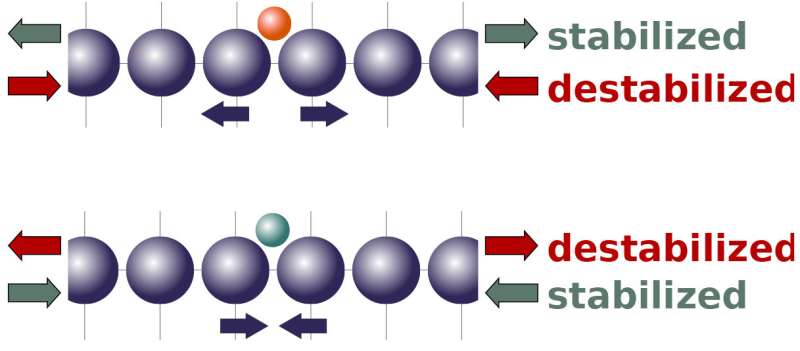New theory shows how strain makes for better catalysts

Brown University researchers have developed a new theory to explain why stretching or compressing metal catalysts can make them perform better. The theory, described in the journal Nature Catalysis, could open new design possibilities for new catalysts with new capabilities.
Catalysts are substances that speed up chemical reactions. The vast majority of industrial catalysis involves solid surfaces, often metals, that catalyze reactions in liquids or gases. A catalytic converter on a car, for example, uses metal catalysts to pluck toxins out of exhaust fumes. There's also interest in using metal catalysts to convert carbon dioxide into fuels, make fertilizers from atmospheric nitrogen and drive reactions in fuel-cell cars.
Research in recent years has shown that applying a strain to metal catalysts—either compression or tension—can in some cases change the way they perform.
"Strain is a really hot topic in catalysis right now," said Andrew Peterson, an assistant professor in Brown's School of Engineering and co-author of the research. "We've starting seeing things happening under strain that aren't easily explained by the traditional theory of how catalysts work. That got us thinking about an alternative framework for this question."
A metal catalyst works by causing reactants to bind to its surface, a process known as adsorption. Adsorption breaks chemical bonds of the reactant molecules, enabling various stages of a chemical reaction to take place on the metal's surface. After the reaction stages are complete, the final product is released from the catalyst through the reverse process, called desorption.
A catalyst's key property is its reactivity, meaning how tightly it binds chemical molecules to its surface. Catalysts need to be somewhat reactive for binding to happen, but not too reactive. Too much reactivity causes the catalyst to hold molecules too tightly, which may hinder some stages of the reaction or make it so the final products can't desorb.
It's been shown in recent years that applying a strain to a catalyst can tune its reactivity, and there's a well-established theory for how it works. Generally speaking, the theory predicts that tensile strain should increase reactivity, while compression should reduce it. However, Peterson and his group kept encountering systems that aren't easily explained by the theory.
That got the researchers thinking about a new way to view the problem. The traditional theory describes things on the level of electrons and electron bands. The new theory zooms out a bit, focusing instead on the mechanics of how molecules interact with a catalyst's atomic lattice.
Peterson and his team showed that molecules bound to a catalyst's surface will tend to either push atoms in the lattice apart or pull them closer together, depending upon the characteristics of the molecules and the binding sites. The different forces produced by molecules have interesting implications for how external strain should affect a catalyst's reactivity. It suggests that tension, which stretches a catalyst's atomic lattice, should make a catalyst more reactive to molecules that naturally want to push the lattice apart. At the same time, tension should decrease reactivity for molecules that want to pull the lattice together. Compression—squeezing the lattice—has an inverse effect.
The new theory not only helps explain previously puzzling results, it makes important new predictions. Specifically, it predicts a way to break traditional scaling relations between catalysts and different types of molecules.
"Scaling relations mean that, under normal circumstances, when you increase a catalyst's reactivity for one chemical, it increases the reactivity for other chemicals as well," Peterson said. "Similarly, if you decrease reactivity for one chemical, you decrease it for others."
Those scaling relations cause troublesome tradeoffs when trying to optimize a catalyst. Getting the perfect reactivity for one chemical could cause another chemical to bind too tightly (or too loosely), potentially inhibiting some stages of a reaction. But this new theory suggests that strain can break those scaling relations—enabling a catalyst to simultaneously bind one chemical more tightly and another more loosely, depending on the chemical's natural interaction with the catalyst's atomic lattice and the way that the strain field is engineered on the catalyst surface.
"Now you can start to think about really fine tuning catalysts to perform better throughout different reaction steps," Peterson said. "That could dramatically improve a catalyst's performance, depending on the chemicals involved."
Peterson's team has started putting together a database of common reaction chemicals and their interactions with different catalyst surfaces. That database could serve as a guide for finding reactions that could benefit from strain and the breaking of scaling relations.
In the meantime, Peterson hopes the work they've done thus far will provide that catalysis community with a new way of thinking about strain.
"We're trying to give a framework that provides a more intuitive understanding how strain works in catalysis," Peterson said. "So as people design new catalysts, they can think of ways to better harness these strain effects."
More information: Alireza Khorshidi et al, How strain can break the scaling relations of catalysis, Nature Catalysis (2018). DOI: 10.1038/s41929-018-0054-0
Journal information: Nature Catalysis
Provided by Brown University



















